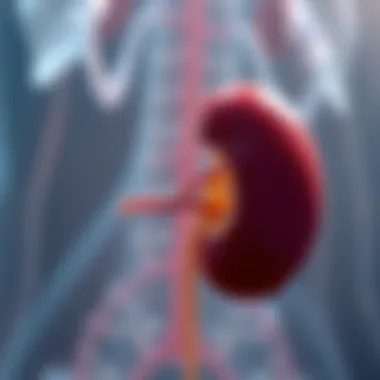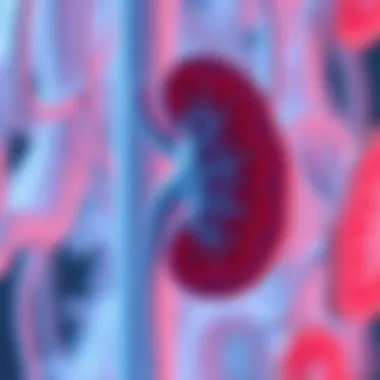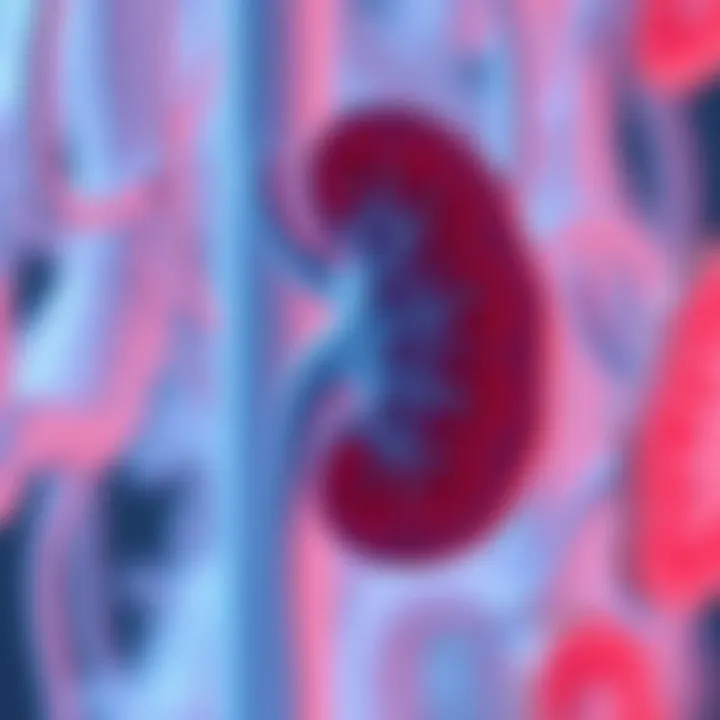Advancements in Regenerative Kidney Therapies


Intro
The landscape of nephrology is evolving as the focus shifts towards regenerative therapies aimed at restoring kidney function. Traditional treatment options have often failed to provide long-term solutions for those battling kidney disease. This is where regenerative medicine holds promise, tapping into biological processes to repair or replace damaged renal tissues. This comprehensive look at regenerative kidney therapies not only explores current advancements but also contemplates future aspirations within this critical healthcare sphere.
Understanding the biological underpinnings and mechanisms of kidney regeneration lays the groundwork for innovative therapies. New methods, such as stem cell applications and tissue engineering, are transforming the approach to renal care, while also sparking discussions around ethical dilemmas and technological challenges. Through exploring current developments, we aim to map out a clearer future direction for practitioners, researchers, and patients alike.
As we navigate this uncharted territory, our guiding inquiry centers on questions pivotal to the advancement of regenerative kidney therapies. How can cellular repair mechanisms be leveraged? What innovative techniques show the most promise? And importantly, what ethical considerations urge a deeper reflection on these advancements?
Methodology
This section outlines the structured approach taken to analyze the advances in regenerative kidney therapies, encompassing both qualitative and quantitative research methods to ensure a comprehensive evaluation of the current landscape.
Study Design
The study was conceived as a systematic review of current literature surrounding regenerative kidney therapies. By narrowing our focus to peer-reviewed articles and pertinent clinical trials conducted within the past decade, we aimed to encapsulate a dynamic range of interventions and outcomes discovered in nephrology. This approach allowed for a rigorous examination of research quality, study designs, and findings.
Data Collection Techniques
Data was gathered through multiple avenues, including:
- Direct analysis of clinical trials published in medical journals.
- Surveys conducted with professionals in nephrology to gauge firsthand insights and outcomes.
- Comprehensive reviews found in databases like PubMed and Scopus.
This multifaceted collection method enhances the validity and applicability of our findings.
Discussion
The exploration of regenerative kidney therapies reveals a spectrum of innovative techniques and potential outcomes. However, it also surfaces essential considerations in interpretation and future direction.
Interpretation of Results
The results underscore a pivotal shift in how kidney diseases can be approached. Cell-based therapies, particularly stem cell treatments, have shown potential in early studies, aligning with biological principles of regeneration and repair. Tissue engineering further complements these approaches, offering methods to create scaffolding that encourages natural tissue organization and function.
Limitations of the Study
While this review highlights significant advances, it is crucial to acknowledge several limitations. Many studies lacked large sample sizes or had short follow-up periods, raising questions about the long-term efficacy and safety of these therapies. Moreover, variations in study designs could make it challenging to draw definitive conclusions across different therapeutic approaches.
Future Research Directions
As we look to the horizon, what follows is more than speculation; it's a call to action for continued inquiry. We must delve deeper into the intricacies of cellular behavior and tissue regeneration. Establishing standardized protocols for clinical trials could also enhance the robustness of future research. Areas ripe for exploration include the optimization of robotic-assisted techniques in tissue engineering and further investigations into ethical implications surrounding stem cell sourcing.
"The future of kidney care lies at the intersection of biology and technology; innovation here could redefine outcomes for countless lives engaged in the battle against kidney disease."
Overall, regenerative kidney therapies signal a transformative leap forward in nephrology, providing both hope and challenge. As we build on this foundation, the pathway is illuminated for future discovery, fostering potential breakthroughs that could substantially redefine kidney disease management.
Intro to Regenerative Kidney Medicine
Regenerative medicine is transforming how we perceive and address chronic ailments, particularly those affecting the kidneys. This scope of medicine not only prioritizes healing but emphasizes restoring function, which is crucial for ensuring quality of life. With an ever-increasing prevalence of kidney diseases globally, there is a significant need to explore innovative treatments that can address renal degeneration at its core.
Regenerative kidney medicine focuses on leveraging biological systems to rejuvenate kidney function. The importance of this approach cannot be understated. Unlike conventional treatments, which often merely manage symptoms, regenerative therapies aim to repair and regenerate damaged tissues. This objective holds the potential to revolutionize patient outcomes, transforming lives by reducing the need for dialysis or kidney transplants.
However, delving into this healing journey is hardly a walk in the park. It encompasses understanding complex biological mechanisms, tackling ethical quandaries surrounding stem cell sourcing, and bridging the gap between laboratory research and clinical applications. Each of these facets contributes to a broader picture of how regenerative approaches can treat kidney disease, but they also introduce numerous hurdles that practitioners and researchers must navigate.
In the sections that follow, we will unpack the intricacies of kidney function and structure, shedding light on the very systems that regenerative therapies seek to heal. The next segment will delve into the burden of kidney diseases, underscoring the necessity for advancements in therapy. These considerations underscore the urgency of focusing on regenerative kidney medicine as we venture into more profound discussions about current developments and future directions.
Understanding Kidney Function and Structure
The kidneys are remarkable organs, functioning as the body’s natural filtration system. They regulate blood pressure, maintain electrolyte balance, and filter waste from the bloodstream. Their intricate structure includes billions of nephrons—tiny units where the filtration of blood occurs. Each nephron consists of a glomerulus, which filters the blood, and a tubule, which reabsorbs essential nutrients and water. This anatomical arrangement is vital for maintaining homeostasis within our bodies.


To understand how to regenerate kidney tissues, one must first appreciate this dynamic architecture. The kidneys are not merely sacks of tissue; they are complex organs that evolve in response to various stimuli and conditions. For example, if the kidneys face prolonged stress due to high blood pressure or diabetes, they can undergo structural changes, leading to chronic kidney disease (CKD). Recognizing these changes is key to developing effective regenerative therapies.
The Burden of Kidney Diseases
Kidney disease presents a substantial challenge, impacting millions worldwide. More than 850 million people are affected globally by some form of kidney disease, a staggering statistic that highlights the gravity of the issue. Chronic kidney disease, in particular, remains one of the top causes of morbidity and mortality, often leading to complications that can severely diminish patients' quality of life.
The prevalence of end-stage renal disease (ESRD) has consequently surged, necessitating treatments such as dialysis or transplantation. These options, while lifesaving, come with their own set of burdens, including high costs, time commitments, and the constant specter of complications. Moreover, access to kidney transplant programs is limited, often leading to prolonged waiting periods and uncertain futures for many individuals.
The economic impact is equally profound. The costs associated with managing kidney disease are estimated to consume significant portions of healthcare budgets worldwide. These realities create a pressing demand for effective, lasting therapies that address the underlying causes of kidney damage, rather than simply treating symptoms.
In understanding the unique functions of the kidneys, as well as the overwhelming burden that kidney diseases impose on patients and healthcare systems, the case for regenerative medicine becomes clear. As research evolves, the hope is that we can transcend traditional boundaries and unlock the potential of regenerative therapies to profoundly change the landscape of kidney treatment.
Biological Mechanisms of Kidney Regeneration
The biological mechanisms that underlie kidney regeneration are essential to understanding how interventions can promote healing and restore function to this vital organ. As the body strives to repair itself, it harnesses a complex interplay of cellular activities and signaling pathways aimed at restoring renal health. These mechanisms not only provide a framework for developing novel therapeutic approaches but also highlight the inherent capacity of the kidney to recover from injury.
Cellular Regeneration in the Kidney
Cellular regeneration in the kidney is a process that entails numerous types of cells collectively promoting repair following nephron damage. At the core of this phenomenon are renal epithelial cells, which exhibit impressive agility in adapting to injury. These cells can enter a phase known as dedifferentiation, where they revert to a more primitive state. This transformation allows them to proliferate, migrate to the damaged site, and re-establish the renal architecture.
- Significant types of renal cells involved:
- Proximal tubular cells: These are among the first responders to injury. Their ability to undergo repair is crucial when the kidney faces acute stress.
- Mesenchymal stem cells: Derived from various sources, such as bone marrow, these cells can migrate to the injury sites and contribute to the regenerative process, facilitating healing and supporting tissue repair.
- Endothelial cells: These cells line the blood vessels within the kidney and play a pivotal role in restoring blood flow to injured areas, crucial for nutrient delivery and waste removal.
A deeper understanding of these cellular regenerative processes can illuminate how we can harness or enhance them through therapeutic strategies. By employing approaches such as stem cell therapy or other innovative techniques, there's potential to amplify the repair mechanisms, ultimately leading to better outcomes for individuals suffering from kidney-related ailments.
Role of Stem Cells in Renal Repair
Stem cells have carved out a niche in regenerative medicine for their remarkable potential to differentiate into various cell types, including those found within the kidney. Their role in renal repair is multifaceted and critical, serving several key functions:
- Differentiation potential: Stem cells can differentiate into nephron-like cells, bridging the gap left by damaged cells and replenishing the renal tissue.
- Paracrine signaling: Beyond direct differentiation, stem cells contribute to the regenerative environment by releasing growth factors and cytokines that promote healing, inflammation modulation, and survival of nearby cells.
- Injury response enhancement: Stem cells are tactical players in responding to kidney injuries, often enhancing the local microenvironment to facilitate the recovery process.
Recent research has suggested that stem cell therapies, particularly those involving induced pluripotent stem cells (iPSCs), could revolutionize kidney repair methodologies. While still cautious in application, the implications of combining stem cell technology with traditional renal therapies could reshape how nephrologists approach treatment.
In summary, the intricate biological mechanisms that govern kidney regeneration reveal not just a natural resilience, but also a promising avenue for therapeutic development. As researchers delve deeper into cellular behaviors and stem cell applications, the potential exists to refine strategies that harness these principles—ultimately leading to improved care for patients grappling with kidney disease.
"Understanding these biological processes might not only help us in developing effective treatments but also empower us to appreciate the body’s natural repair capabilities better."
For more insights on kidney health and regeneration, resources like National Institutes of Health, Cleveland Clinic, and American Society of Nephrology can provide valuable information.
Innovative Therapies in Development
The progression of regenerative kidney therapies promises not just to treat, but to potentially reverse kidney dysfunction. Innovative therapies, ranging from stem cell treatments to tissue engineering techniques, are being carefully designed and tested. These advancements aim to restore renal health more effectively than traditional approaches. With kidney disease affecting millions globally, the exploration of new therapies holds immense significance.
Stem Cell Therapy for Kidney Restoration
Stem cell therapy represents a pivotal point in the realm of regenerative medicine for kidney restoration. Because stem cells have the ability to differentiate into various cell types, they offer a pathway to regenerate damaged kidney tissues. This therapy is appealing for a few reasons:
- Versatility: Stem cells can transform into the specific cells needed for kidney functions such as filtration and urine production.
- Potential for Repair: In pre-clinical and early clinical trials, stem cells have demonstrated the ability to promote tissue repair and functional recovery in animal models.
- Immune Modulation: Stem cell therapy can also help modulate the immune response, potentially reducing inflammation and further damage.
However, stem cell therapies are not without their challenges. From sourcing the appropriate stem cells—whether they are from the patient’s own body, embryonic sources, or induced pluripotent stem cells—to the need for further studies on long-term effects, the field is rife with complexities yet to be fully navigated.
Tissue Engineering Approaches
Tissue engineering stands as a beacon of hope in kidney regeneration. It involves creating functional kidney tissues using a combination of biomaterials, cells, and biochemical factors. This approach focuses on:
- Biomimicry: Engineers aim to create structures that closely replicate natural kidney architecture and function. This can involve scaffolds made of biocompatible materials to support cell growth.
- Customization: Individualized tissue constructs may be developed to fit the unique requirements of the patient, tailored to their specific pathology or genetic background.
- Laboratory Compassion: The possibility of growing kidneys in lab settings paves the way for transplant solutions that could circumvent organ donation shortages.
Yet, there are hurdles, including ensuring vascularization of engineered tissues to provide adequate nutrient flow and integrating these constructs into a patient’s system fully. The field remains keen on finding solutions to these challenges, as successful integration could revolutionize how kidney failure is treated.


Gene Therapy and its Implications
Gene therapy has emerged as a fascinating avenue in the quest for kidney regeneration. By directly targeting the genetic components responsible for kidney diseases, researchers hope to correct abnormalities and restore normal function.
- Precision Targeting: Techniques like CRISPR allow precise editing of genes tied to renal pathophysiology, potentially halting disease progression.
- Sustainable Solution: Unlike stem cells, which might provide temporary relief, gene therapy could offer long-term solutions by correcting the root cause of diseases like polycystic kidney disease or diabetic nephropathy.
- Hope for the Future: Researchers are exploring the use of viral vectors to deliver therapeutic genes effectively, though safety remains a critical concern.
Clinical Applications and Trials
The intersection of clinical applications and trials in regenerative kidney therapies is crucial, embodying the shift from laboratory research to tangible patient outcomes. This phase underscores the importance of validating new techniques and therapies in a real-world context. For healthcare professionals, researchers, and students, understanding this translation is key. It reveals how scientific discoveries can be meticulously crafted into effective treatments, ultimately improving the quality of life for those afflicted by kidney disease.
In this domain, clinical trials serve as the backbone of progress. They not only evaluate the safety and efficacy of innovative therapies but also build a framework for regulatory approval and clinical acceptance. The benefits are manifold, ranging from the provision of evidence-based treatments to the potential for breakthroughs that could redefine patient care in nephrology. By establishing a rigorous testing environment, trials ensure that therapies are thoroughly vetted before reaching the public.
Current Clinical Trials in Renal Regeneration
Current clinical trials are exploring a variety of innovative strategies for kidney regeneration. For example, numerous studies are evaluating the use of stem cells sourced from different tissues, exploring how these cells can regenerate damaged renal structures. One significant area of focus is the testing of mesenchymal stem cells for their capacity to repair kidney injury. Additionally, trials assessing bioengineered kidney tissues made from non-human cells are gaining traction.
Among the most promising clinical trials, the following stand out:
- Stem Cell Applications: Research is ongoing into the efficacy of administering stem cells directly into affected kidney areas. This route shows potential in reversing damage and restoring function.
- Tissue Engineering Approaches: Some trials have ventured into using scaffolds, created from biocompatible materials, that support the growth of kidney cells. The idea is to create a functioning implant that can mimic native kidney properties within the human body.
- Gene Therapy Techniques: Trials in this arena are testing gene editing technologies like CRISPR to correct genetic defects responsible for kidney deterioration.
The outcomes of these trials could redefine how kidney diseases are managed, opening doors to treatments that were previously deemed impossible.
Challenges in Translating Research to Practice
While the road from bench to bedside is paved with potential, numerous challenges lurk along the way. Translating research discoveries into clinical practice can be a herculean task. The first challenge lies in the complexity of kidney diseases themselves. Renal pathologies are multifaceted and vary widely among patients, complicating the development of uniform treatment protocols.
Moreover, ensuring patient safety is paramount. New treatments must go through not only standard clinical testing but must also consider ethical implications associated with somatic cell applications and the long-term effects of experimental therapies. The requirement for stringent regulatory approvals can slow down the deployment of new therapies, although this process is essential for ensuring patient welfare.
Additionally, there lies a knowledge gap between researchers and clinicians. While investigators may be adept at laboratory techniques, their clinical counterparts often need more insight into emerging therapies. This discrepancy can hinder the implementation of cutting-edge research findings into everyday practice and underscores the importance of interdisciplinary collaboration.
In summary, the triumphs and tribulations in clinical applications and trials of regenerative kidney therapies illuminate a pathway forward that is fraught with both promise and caution. Bridging research and practice demands a concerted effort from all stakeholders involved in nephrology, ensuring the patient remains at the center of therapeutic innovation.
"A stream cannot rise higher than its source." - This adage aptly captures the necessity of foundational research in achieving clinical milestones.
For additional reading on systems of clinical trials and their influence on modern medicine, consider visiting resources like ClinicalTrials.gov or the National Kidney Foundation.
Ethical Considerations in Regenerative Medicine
Ethical considerations in regenerative medicine are pivotal as the field advances, particularly in kidney regeneration. This section highlights the complex moral landscape surrounding stem cell research and patient rights. As innovative techniques gain traction, ensuring ethical practices becomes imperative for maintaining public trust and advancing science responsibly.
Ethical Dilemmas in Stem Cell Research
The use of stem cells is arguably one of the most hotly debated topics in modern medicine. A major ethical dilemma involves the source of stem cells, especially where they are derived from embryos. In instances where embryonic stem cells are involved, questions arise about the moral status of the embyros. Here’s a breakdown of some concerns:
- Moral Status: There is significant disagreement over when human life begins. This disagreement plays a crucial role in the ethical discussion surrounding embryonic stem cell use.
- Consent: Obtaining consent from donors and the rights of donors raises ethical questions, particularly in vulnerable populations.
- Research Limits: Balancing the need for vigorous research against the potential for exploitation is another concern, particularly in developing countries where regulations may be less stringent.
The potential benefits of stem cell therapy are profound, offering hope for conditions that are currently untreatable. However, ethical boundaries must keep pace with innovation to ensure respect for all individuals involved in research.
Informed Consent and Patient Autonomy
Informed consent stands as a pillar of ethical medical practice, especially in regenerative medicine. It ensures that patients are provided with all relevant information surrounding the risks and benefits of participating in studies.
It embodies several critical elements:
- Clarity: Patients must fully understand the procedures, potential outcomes, and uncertainties associated with regenerative therapies. This is crucial in helping them make informed decisions.
- Ongoing Dialogue: Ethical practice in medicine extends beyond the initial consent. Continuous communication between the patient and medical team is essential to adapt to new information or changes in the research protocol.
- Patient Rights: Upholding patient autonomy means respecting their decisions at every stage, whether they choose to participate in a trial or withdraw from it.
"Informed consent is not merely a form; it is a fundamental principle of medical ethics that must be integrated into every aspect of care."


In the arena of kidney regeneration, where experimental treatments are prominent, navigating the complexities of informed consent strengthens the relationship between patients and healthcare professionals. Integrating ethical considerations is not merely a regulatory necessity—it’s a moral obligation that reflects a commitment to patient-centered care.
Exploring ethical dimensions in regenerative medicine not only aids in taking sound decisions but also helps in crafting policies that prioritize integrity and respect for human dignity while fostering a conducive environment for innovation.
Future Directions in Kidney Regeneration
The field of kidney regeneration is at a pivotal point, where the confluence of various scientific advancements brings promise for the future. This segment sheds light on how ongoing developments might not only revolutionize treatment but also lead to a more personalized approach to patient care. The significance of targeting regenerative therapies lies in the potential to not just manage kidney diseases but to restore functionality, enhance the quality of life, and ultimately reduce the burden on healthcare systems.
Potential for Personalized Medicine
The notion of personalized medicine in renal therapy underscores a shift toward tailoring treatments that are specific to individual patient needs. Such an approach involves assessing genetic, environmental, and lifestyle factors to prescribe the most effective interventions.
One fascinating aspect of this concept is pharmacogenomics, which looks at how genes affect individual responses to drugs. For instance, a patient with a specific genetic makeup might respond significantly better to a particular stem cell treatment compared to another. Personalized medicine can also mean adjusting the types or doses of therapies based on ongoing assessments, which helps fine-tune interventions for maximum effectiveness.
Furthermore, advancements in biobanking and patient registries allow for the collection and analysis of extensive data on kidney disease. By continuously updating and evaluating this data, researchers can identify patterns that lead to personalized treatment protocols. This kind of flexibility could pave the way for treatments that take into account the unique progression of disease in each patient.
Potential elements to consider in the realm of personalized approaches include:
- Genetic profiling to predict responsiveness to specific therapies.
- Development of custom bioprinted tissues that mimic patients' own kidney structures.
- An evolving understanding of how comorbidities affect kidney disease for more integrated treatment strategies.
Integrating Artificial Intelligence in Research
As we look ahead, one can't overlook the transformative role of artificial intelligence (AI) in reshaping kidney regenerative strategies. Artificial Intelligence is not merely a buzzword but a tool that holds the potential to unlock new dimensions in research and treatment. From analyzing data to developing predictive algorithms, AI paves the way for more efficient and informed decision-making.
Machine learning algorithms can sift through mountains of research data, clinical trials, and patient records, identifying trends and correlations that may elude human eyes. Also, AI can help simulate how different regenerative therapies might perform, guiding researchers in selecting which paths to pursue. This capability could drastically cut down the time required for testing and approval in clinical settings.
“The integration of artificial intelligence into kidney research stands to not only accelerate discoveries but also enhance predictive accuracy in treatment outcomes.”
Several areas where AI could significantly impact kidney regeneration include:
- Patient Monitoring: Using AI to analyze real-time data from wearable devices to personalize treatment regimens.
- Clinical Trial Optimization: AI can identify appropriate patient populations for trials, improving success rates and lowering costs.
- Prediction Models: Developing algorithms that predict disease progression based on various biological and environmental factors.
Ultimately, the future directions in kidney regeneration are brimming with possibilities. The collaboration between personalized medicine and smart technologies paints an optimistic picture, one where kidney diseases could be managed more effectively, potentially changing lives for many around the globe.
The End and Implications for Public Health
The advancements in regenerative kidney therapies represent a significant shift in how we approach renal diseases. These therapies not only hold promise for individuals suffering from kidney ailments but also carry broader implications for public health.
The core of this development lies in the potential to restore kidney function, enhancing the quality of life for patients. As we discussed various innovative strategies, such as stem cell therapy and tissue engineering, their implications extend beyond individual patients to the healthcare system as a whole. An increase in successful treatments could lessen the burden on renal replacement therapies, such as dialysis and transplants. By effectively addressing kidney diseases at their roots, we might see a decrease in healthcare costs related to the management of chronic kidney disease.
"The future of kidney health can be reimagined through regenerative therapies, benefiting not only patients but the entire healthcare landscape."
Another important element is the prospect of personalized medicine. As research continues to explore how individual biological variability affects treatment responses, we've got a chance to tailor therapies specifically to each patient's unique needs. This not only enhances treatment efficacy but also fosters a more patient-centered approach in healthcare, where individuals feel heard and cared for throughout their treatment journeys.
Moreover, the integration of artificial intelligence in research can accelerate the pace of discovery in this field. Data analysis and predictive modeling could lead to more precise interventions and outcomes, further advancing the practice of regenerative medicine.
On the flip side, while these advancements are promising, they come with their own set of ethical considerations and challenges. The necessity for informative consent and the protection of patient autonomy becomes paramount as we navigate through uncharted territories of medical capabilities. Engaging patients in discussions about their options creates a foundation of trust and respect in the patient-physician relationship.
In summary, the developments in regenerative kidney therapies are shaping a transformative horizon for renal health and public welfare. Through ongoing innovation and ethical practices, we can look forward to improved health outcomes for patients while easing the fundamental challenges faced by our healthcare system.
Summarizing the Advances in Regenerative Kidney Medicine
In recent years, we’ve seen remarkable progress in the realm of regenerative kidney medicine. Innovative strategies such as stem cell therapy are being investigated vigorously, offering hope for cellular repair and the restoration of kidney functions. Research indicates that stem cells can differentiate into various kidney cells, effectively replenishing lost or damaged tissues. This biology offers exciting possibilities for those suffering from chronic conditions.
Furthermore, advances in tissue engineering are paving the way for the creation of bioengineered kidneys, which could eventually function in a similar capacity to natural organs. These engineered structures are designed to mimic the complex architecture of kidneys, potentially alleviating the organ shortage crisis.
The exploration of gene therapy to correct genetic defects causing kidney diseases adds yet another layer of advancements. By editing genes associated with kidney dysfunctions, researchers hope to preemptively tackle issues before they manifest into chronic illnesses.
The Importance of Continued Research
The path forward relies heavily on continued research and development. Each stride in this domain is built on the foundation of previous discoveries and learnings. By investing in research, we support not just the potential to innovate but also to verify the effectiveness and safety of emerging therapies.
Funding for research initiatives must become a priority in public health agendas. With the right backing, scientists can delve deeper into trial phases, refining techniques and discovering new therapies that can ultimately enhance patient outcomes.
Collaboration is key in this pursuit. Combining efforts across disciplines—from basic scientists to clinical researchers—will generate a rich ecosystem of ideas and applications, ensuring that findings translate into real-world solutions.







